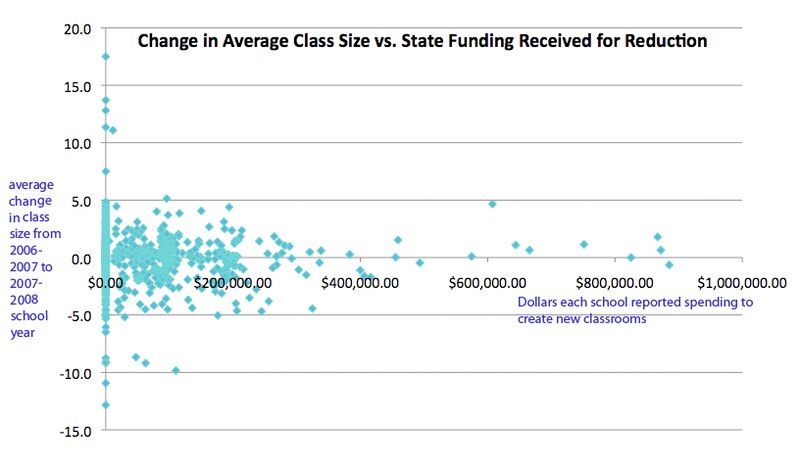
We’ve already reported that average class sizes citywide did not decline last year, despite an infusion of money meant to reduce them. New data suggest the same relationship happens at the school level: Even schools that reported spending hundreds of thousands of dollars on class-size reduction efforts, such as creating new classrooms, did not necessarily see a drop in average class sizes.
Rather, while some schools that reported investing in new classrooms did end up reducing class sizes on average, others actually saw their average class size go up. The data, provided by the Department of Education following a tug–of-war that you might recall, are summarized in the graph above and in a searchable file available here.
The major challenge, according to the schools official who compiled the data, Tania Shinkawa, is not that principals didn’t spend the money as they were supposed to, but that even that pot of money didn’t guarantee that they could lower class sizes across the board.
Take Bronx elementary school PS 57, which reported that it spent $190,000 to open new classes. Let’s be generous and say that the money could pay for three additional teachers. That could go a long way toward reducing class sizes in three grade levels. But would it necessarily lower the entire school’s average class size?
No. That would depend on how many students enrolled at the school, especially in grades and subjects that didn’t get new teachers. It would also depend on the rest of the school’s budget outlook, which, as school officials pointed out when they first released basic class-size data, has not been so good lately. And it would require the school to hire only inexpensive, and therefore inexperienced, teachers. In fact, PS 57 did see its average class size drop by more than one student. But another school, PS 54 in the Bronx, received $185,000 but saw class sizes shoot up on average by about 3 students per class.
The new figures add to reports challenging the effectiveness of the state’s Contracts for Excellence program, which was trumpeted for its novel decision to demand that education dollars produce specific, concrete policy changes — including class-size reduction. The money schools received last year to create new classrooms was part of the Contracts for Excellence program. The database includes how much money each school reported it spent on both adding new classrooms and using team-teaching to bring down the teacher-student ratio. (The graph above reports only on the money dedicated to adding new classrooms.)
Another possible explanation for why the schools did not all see their class sizes decline: They may not actually have spent the money as they said they did. Look through the database and let us know how your school’s reported spending compares to reality.
One other note about the data: There are obviously some major outliers here, as it’s hard to imagine how a school that could really see class sizes going up or down by an average of 10 students. These may simply be a few cases of bad or misleading data.
